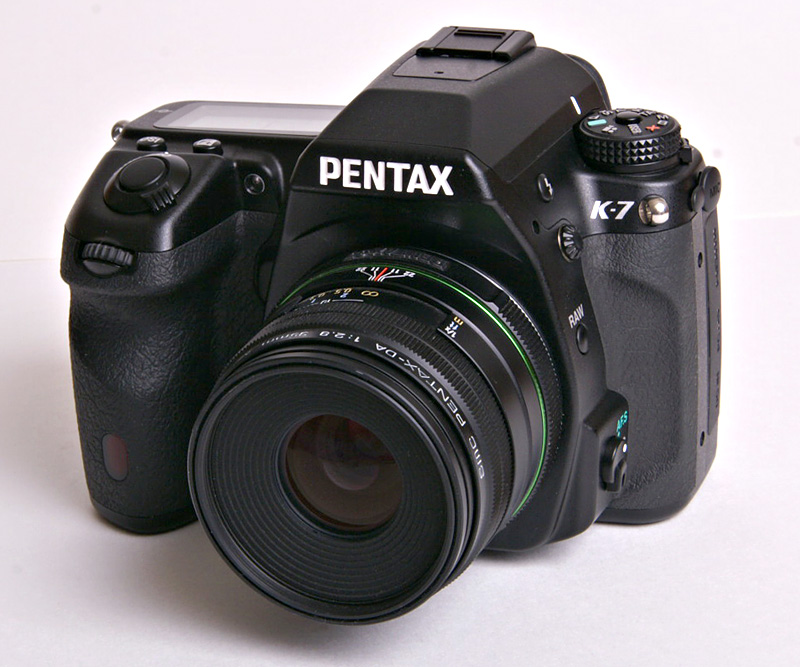 Fast, compact, and quiet—that's the gestalt of the K-7, which is a perfect match to Pentax's beautiful Limited prime lenses.
Fast, compact, and quiet—that's the gestalt of the K-7, which is a perfect match to Pentax's beautiful Limited prime lenses.
Finally, finally, finally, a Japanese camera manufacturer has broken with the size/quality lockstep that has been like a hard-and-fast, albeit unspoken rule among Japanese cameramakers throughout most of the digital era. I've long noticed it and bemoaned it many times...better cameras always have to be bigger, and smaller cameras are always aimed at lower levels of the market, typically the undemanding "entry level" that doesn't mind the inevitable cut corners. The new K-7 supersedes the K20D as Pentax's top-of-the-line offering, and it's higher spec'd in almost every way, but it's appreciably smaller than even the smallish K20D...and much smaller than something like the Nikon D700.
Well, all right.
Features (some of 'em)
Okay, now, as you might expect, the new camera, which will list for $1,299, has video. But since that's not my thing, I won't say much about it—I'm sure you're capable of reading the spec sheet for yourself. But here's a rundown of the features you probably expect, followed by a few you don't:
• Although not recommendably dunkable, the camera is rain- and spray-proof with the DA Star lenses. And it'll probably be okay if you drop it in the pool by mistake. It's also dust-proof—and cold-proof, too, to –10°C/14°F.
• "New 14.6 megapixel CMOS sensor rebuilt from the ground up to minimize noise." But they won't let me show you pictures yet (both the K-7's I have are pre-production). More on that when I get a production camera with the final firmware.
• Faster throughput and faster autofocusing
• Live View
• Shake Reduction (i.e., body-integral image stabilization)
• New 77-segment metering system
• HD movie capture; built-in microphone (although an external microphone is recommended)
• Optional ($230) battery grip
New stuff:
• Programmable embedded copyright function
• For tripod work, the camera uses the motors that effect the Shake Reduction to allow you to touch up your framing using the 4-way pad. Nice touch, and one I imagine will soon become standard across the industry for cameras that have body-integral image stabilization.
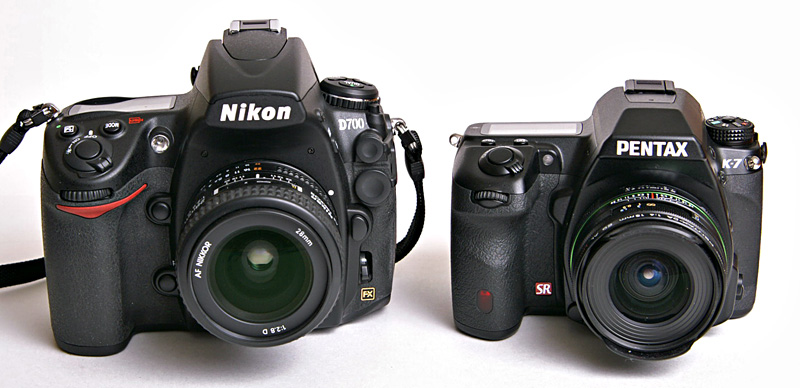 Big honkin' Nikon next to the cruiser-class Pentax. AF-Nikkor 28mm ƒ/2.8 on the left and DA 15mm ƒ/4 on the right. As shown, 1,306g vs. 937g on the ol' Pelouze scale.
Big honkin' Nikon next to the cruiser-class Pentax. AF-Nikkor 28mm ƒ/2.8 on the left and DA 15mm ƒ/4 on the right. As shown, 1,306g vs. 937g on the ol' Pelouze scale.
Shutter noise
One of the big deals about the K-7 to me is the shutter noise. It's very quiet. The main point of having a smallish camera is so that it's easy to carry it around with you wherever you go; and if you're using it as a visual notepad, you might call it, then quite often it's useful not to call attention to yourself by clacking away piercingly and drawing stares from anyone nearby. The K-7's shutter is quiet for an SLR by any standard, both in the level and the type of noise it makes. The AF noise is actually louder than the shutter.
Handling
Although I'm sure Pentax has worked very hard on the many improvements embodied in the K-7, to some extent we take these incremental improvements for granted (fairly or not): it's faster, it meters better, it's got more features (I like the way it automatically corrects image orientation, for example). Etc. But really, the big deal about the K-7 is handling. It's a carry-around style of camera, and feels good in your hand and on your shoulder. In case you can't quite read the picture above, my son is holding the camera up in the air; the point is that the handgrip is beefy and deep enough that you can easily hold the camera with just your four fingers stuck in the grip while you change cards with the other hand. (The card compartment, despite being weatherproof, is the new style that opens with thumb pressure, too, like the D700 and other newer cameras. It's an improvement on the overly fussy latch on the K20D.)
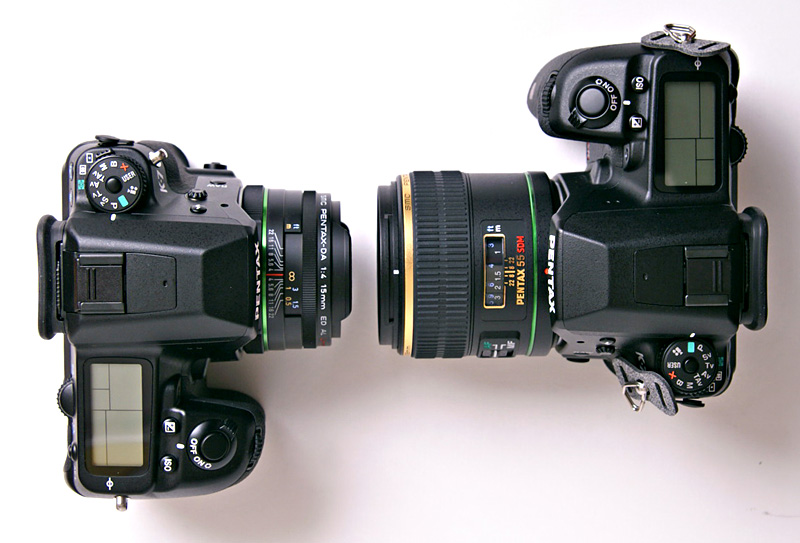 A brace of K-7's...on the left with the DA Limited 15mm ƒ/4, on the right with the DA Star 55mm ƒ/1.4.
A brace of K-7's...on the left with the DA Limited 15mm ƒ/4, on the right with the DA Star 55mm ƒ/1.4.
I'll have more to say about the K-7, I'm sure, in the weeks to come, especially if and when Pentax sends me a final production version with no restrictions on image publication.
So, more anon.
Oh, and one more trivial point: it's handsomer than the K20D, too.
Mike
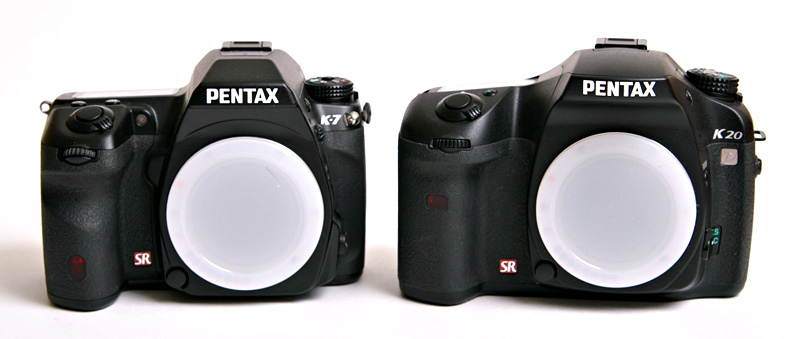
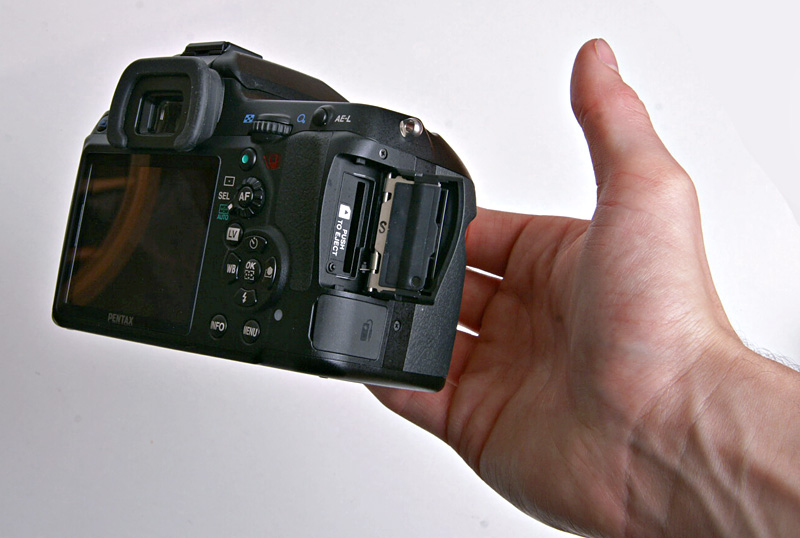



I'm dying to find a good vacation camera: small, light, good build, good-quality images. Part of me wants to invest in a Canon G10 but I know that a non-SLR won't satisfy my need to shoot at higher ISOs from time to time. Seeing the specs for the K-7 makes me want to revisit other Pentax models to see how they'd fit.
Posted by: Terry Manning | Thursday, 21 May 2009 at 06:45 PM
What do you think about the live view qualities of the k-7? Has it been improved compared to the k20?
Is it usable now? As a friend of mine said the k20d was only able to offer you about 20 seconds, then the body stopped the liveview mode. So you could not use the mode permanently.
Posted by: Dan | Thursday, 21 May 2009 at 07:49 PM
This is my dream camera. It is tough and will fit in my bike packing set up. I've been wanting close to buying both a D300 or an E3 many times but could not come to term with the size. The K-7 appears to have the right feature set in the size I was looking for.
Besides, it will look different than all my friends shooting those big Nikon's and Canon's.
I have placed an order for one of these. July can't come soon enough.
Thank you Pentax. I can't wait.
Posted by: Gnat | Thursday, 21 May 2009 at 09:21 PM
AlexMonro wrote:
"Tom, I read in the specs on one of the preview sites that the K-7's sensor shift is limited to approx 1mm each way from centre. So, at about 4% of frame width (8% from one extreme to the other), it's probably not really enough for panoramic stitching."
Can somebody who knows more about the precision of that sensor-shift mechanism tell me if it would be possible to move the sensor by exactly half a pixel along each axis, thus creating two interlaced images that can be combined for more resolution? I imagine it would be impossible to exactly double the resolution because each sensor well averages intensity over an area, but it could yield some improvement over base resolution.
Posted by: expiring_frog | Thursday, 21 May 2009 at 09:54 PM
"Can somebody who knows more about the precision of that sensor-shift mechanism tell me if it would be possible to move the sensor by exactly half a pixel along each axis, thus creating two interlaced images that can be combined for more resolution?"
expiring_frog,
I'd like you to do me a favor. First, stop thinking about this for a full two weeks. Then, at the end of that time, never think of it again.
Mike
(With apologies to Wendell Webb)
Posted by: Mike Johnston | Thursday, 21 May 2009 at 11:24 PM
You will be sending me the K-7 once you are done with your final review. Right?
Posted by: Bran Everseeking | Friday, 22 May 2009 at 12:52 AM
@Mike: :D. All right, I'll stop.
But for background, I share an office with four people who do computational photography (i.e. the same bunch of people who created the focus-after-the-fact plenoptic camera you wrote about long ago). So I hear a lot of this sort of stuff.
Say the D700 had sensor-shift. In normal use, you get the excellent low-light performance. Put it on a tripod, give it double the exposure time (or double the ISO and keep the old exposure), and in that time the camera takes two shots separated by a half-pixel shift. Voila, there's your 24mp (or thereabouts) landscape camera with one stop less sensitivity. Assuming sensor-shift is already this precise, it saves over the cost of the D3X sensor, no?
Conceptually, you're using the camera like a scanning back. Here's the same idea applied to the temporal domain, i.e. to video, by the group mentioned above: http://graphics.stanford.edu/papers/highspeedarray/
The WP page has decent links:
http://en.wikipedia.org/wiki/Computational_photography
Like it or not, Mike, it's all coming to a camera near you :).
Posted by: expiring_frog | Friday, 22 May 2009 at 03:43 AM
Ok, turns out Boeing, of all companies, holds the patent, issued last September.
http://www.patentstorm.us/patents/7420592.html
Posted by: expiring_frog | Friday, 22 May 2009 at 03:52 AM
"You will be sending me the K-7 once you are done with your final review. Right?"
Brian,
Sure. Be waiting for the FedEx truck, okay?
Mike
Posted by: Mike Johnston | Friday, 22 May 2009 at 07:13 AM
"I share an office with four people who do computational photography (i.e. the same bunch of people who created the focus-after-the-fact plenoptic camera you wrote about long ago). So I hear a lot of this sort of stuff."
Really? That's very cool....
Mike
Posted by: Mike Johnston | Friday, 22 May 2009 at 07:17 AM
I am a blue collar worker in northern WI. So my last "new" camera was a Minolta X700. Then I bought used Canon Elans. Then a used Casio to "learn" digital. Then a used Canon D30. Then a used Pentax *ist DS. Now I've been waiting for Sony to upgrade the A700. BUT, if the IQ of this camera checks out, I'm buying this as soon as it's available. Are you listening Pentax; crank up the factory! I am going to sell all my old equipment. I'll even sell some of my wife's things (hope I don't get caught!)
Didn't Ctein comment once, about buying new equipment when it came out? Now that's enjoying life!
Posted by: Edward Mundt | Friday, 22 May 2009 at 11:17 AM
In finder digital preview = No. But a camera level indicator, and live view.
Custom lens calibration = Still there, 20 lenses worth.
Tilt/Swivel LCD = not needed. It has an HDMI out socket for your LCD TV, or, hopefully, an aftermarket battery powered HD LCD screen about 8" to 13" diagonal.
Posted by: Joe McAllister | Friday, 22 May 2009 at 04:57 PM
Hi Mike,
How's the SD card door? Does it open easily like the Nikon D80 (which I find a bit flimsy)?
Or is it, hopefully, sturdier and not too easy to open like the Canon 40D type of door?
Thanks!
Posted by: Diego Lorenzo Jose | Friday, 22 May 2009 at 10:36 PM
A white paper/brochure on the K-7 has been posted by Pentax USA.
http://www.scribd.com/doc/15712448/K7-Brochure-Copy
Posted by: Spiny Norman | Friday, 22 May 2009 at 11:29 PM
100% viewfinder? Great stuff, and in an ideal world every SLR should have one.
In an ideal world every SLR should have a viewfinder where glasses wearers can see the whole screen at once. What is the K7 like?
Posted by: Roger Bradbury | Saturday, 23 May 2009 at 10:46 AM
It is rather more complicated to weather-seal a camera with tilt/swivel screens so I don't mind Pentax's choice...
Posted by: Ollivier Robert | Monday, 25 May 2009 at 04:13 AM
Complicated to weatherseal an articulated viewscreen dslr? Maybe for Pentax it is. Was not difficult for Olympus with their E3 which sells at identical price point K-7 will launch at in July or some say August... No HD video on E-3 however most photographers say they can do without video so one should not overlook Olympus E3 for same money since they delivered articulated viewscreen in weatherproof body. E3 has image stabilized body too, just like Pentax. E3 has dual card slots, pentax has one card slot. Always best to shop around unless you're married to only one system.
Posted by: Lindy | Tuesday, 02 June 2009 at 01:54 PM
The K-7 has no room for the tilt/swivel mecehanism to the external LCD - the camera is simply too smal for that. It needs space for the buttons also. Look at the competition, they have placed the buttons under and above the LCD because the LCD moving mechanism takes up so much space. Having an extra row of buttons underneath the LCD would make the K-7 taller than it is today, and I wouldn't welcome a bigger K-7.
Posted by: Raphael | Wednesday, 10 June 2009 at 06:04 AM